4 European Events Harmonizing Art, Nature, and Techno Music
Techno and electronic music have always shared an intimate relationship with art, intertwining rhythms, beats, and melodies with visual expressions...
Celia Leiva Otto 30 May 2024
The British Landscape: where do we start? From Turner to Hogan the British landscape presents a constant challenge to artists to capture its elusive moods. Landscape painting is deeply soulful, often telling stories of homeliness and comfort. At the same time, it can be filled with desperate longing, desolation, and even rage. In this article, we will look at a small selection of British landscape painters. Some names will be familiar, and one or two may not!
A painting generally has to have two main features to qualify as a landscape: land and sky. A landscape is usually a wide-angle view that allows, for example, a mountain range to be more fully depicted. A narrow-angle reduces the sense of vastness, but can instead draw attention to a specific moment in its life. Features like waves crashing against cliffs, or tiny cottages nestled among rocks, are effectively portrayed like this.
Our short journey through a selection of British landscapes begins with Welsh artist Kyffin Williams (1918-2006). Born in Anglesey (and he also died there), Kyffin Williams was educated at the Slade School of Fine Art. Initially, he was told that he couldn’t draw but graduated from the Slade with the Portrait Prize. In 1968 he spent some time in Patagonia after having won a scholarship to study there. He focused on landscapes and adjusted his palette considerably. When he returned he went back to Anglesey where he spent the rest of his life.
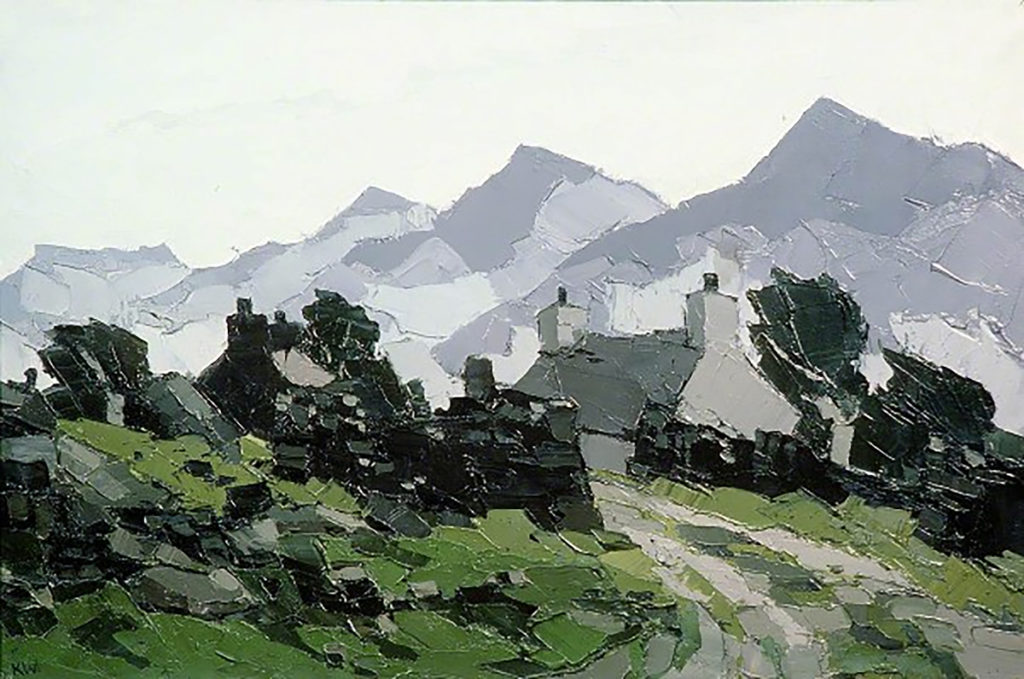
Painted using a confident, heavy impasto technique this landscape painting shows a view of mainland Wales, not far from Anglesey. Williams has made his marks bold and angular to bring out the hard, grey granite rocks that typify this area. The faded peaks give the impression of distance in comparison to the immediacy of the dark foreground. The various grey tones of the rocks blend with olive and sage as they tune in to the more vibrant greens of the grass. Huddled in between these worlds of land and sky there is a cottage. It too possesses the same chiseled rawness of the surrounding landscape, as though it had grown up out of the living rock. The scene is both living yet barren, comforting yet harsh, and homely yet isolated. This painting is filled with emotional contrasts that have been executed in a bold and unforgiving style.
As British landscape painters go, Williams may not be so well known outside the UK, however, Turner (1775-1851) certainly is. Attending the Royal Academy of Arts at age 14, Turner’s talent was spotted early. During his career, he came to be recognized as an artistic genius, described by the English art critic John Ruskin as an artist who could “stirringly and truthfully measure the moods of nature”. It is his particular talent for capturing this mood that seduces any viewer of his paintings. Through his ability to paint those aspects of a landscape that have no corporal substance, for example, light or motion, he conveys to us that which seems impossible without seeing it first hand.
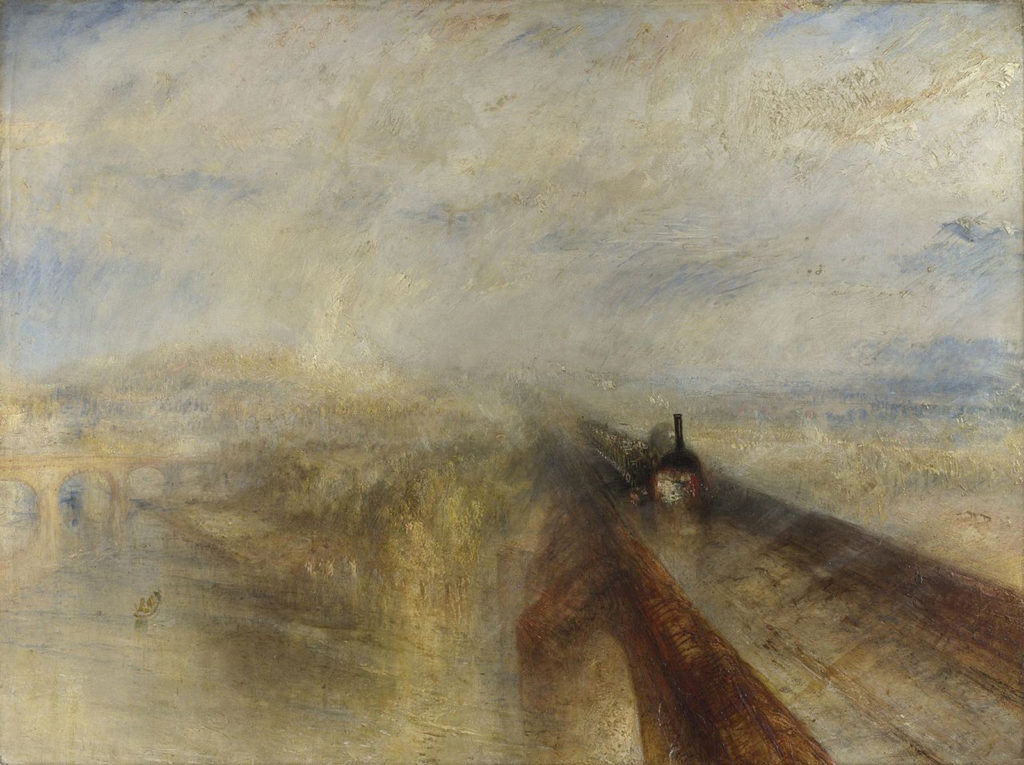
The Victorian era famously saw the rise of steam power. British engineers had been experimenting with the design of steam engines from as early as 1784. By the time of this painting, exciting advances had been made and steam-powered locomotives were becoming part of daily life, and indeed part of the landscape.
Rain, Steam, and Speed capture the excitement which high-speed travel across the British landscape brought to the Victorian era. It also speaks of this phenomenon as though it were a moment of creation. The landscape bears witness to the birth of a new reality in which slick, metal monoliths are hurled through it. It represents not only the speed of the train but also the speed of cultural progress. The train emerges out of its own miasma slipping effortlessly along the viaduct. By contrast, a small fishing boat to the bottom left of the painting sits motionless on the water. Clouds of steam billow down and begin to obscure it. A hare scatters on the tracks before the advancing train. The fishermen, the maidens on the riverbank, and the hare represent the continuance of a daily life that is now forever changed.
Turner became more and more reclusive as he aged but he also became more experimental with his techniques. In Rain, Steam and Speed we see a British landscape laid out in a classical style, with solid geometry perfectly balancing the elements. We also see Turner’s “vivid response to the modern world”.
Paul Nash (1889-1946) was one of the first war artists and a proponent of early modernism. He attended the Slade School of Art where he focused on landscape painting. He was specifically inspired by British landscapes that retained traces of ancient human activity. Nash enlisted in the army in 1914, completing his officer training in 1916. He found himself on the Western Front (Ypres) by 1917 but returned to London after sustaining an injury. A few days afterwards nearly all of his unit were killed.
While recuperating he worked on the drawings that he had made while in Ypres. The resulting exhibition caught the attention of war artist Christopher Nevinson who urged Nash to become a war artist himself. Nash then endured the 1918 Western Front of World War One. Increasingly grim, he endured stinking trenches, endless rain, freezing winter conditions, and shellfire. He watched the people and the landscape around him die. The resulting art mirrored the realities of war. Nash held a lens up to the horrors of the front line. He was a visual reporter and did not sugarcoat his images. In his work of this period, we see everything from the destroyed landscape to the destroyed people. Corpses, huge shell craters, barbed wire, and barely living soldiers feature without apology.
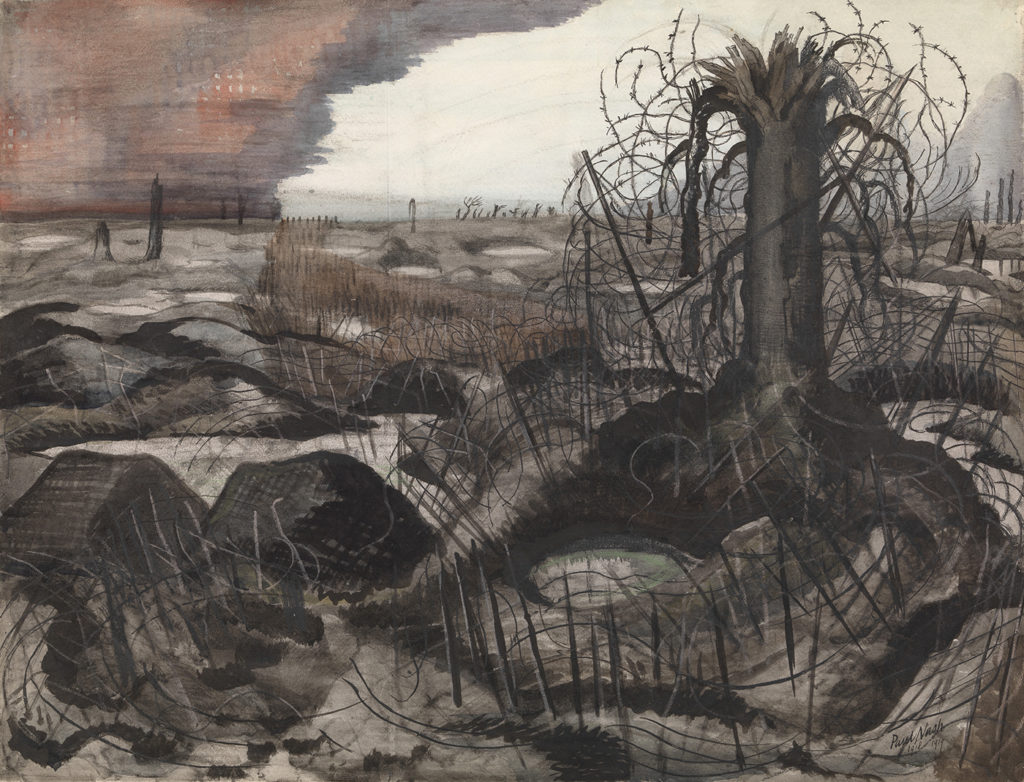
In Wire Nash shows us a barren, bombed wasteland of blackened stumps and broken earth. Nothing lives there or could live there. The landscape recedes unchanging into the distance. Barbed wire strangles the splintered tree in the foreground, coiling about it and emanating away from it as though it has a twisted life of its own. In a letter to his wife Nash describes himself as a “messenger” recording and returning with “bitter truth”.
Painter and sculptor Alan Harris was born in London in 1954 and grew up knowing that he had a love for painting. The people of 1950s post-war Britain had a “mend and make do” mindset: initiative and creativity were default settings. Harris’ father transferred his skills to his son, but it wasn’t until later in life that he became a full-time artist and craftsman. Now he lives and runs a studio in Newcastle in the north of England.
Harris is perhaps better known for his cityscapes and sculptures, but Countryside caught my eye for very particular reasons. His biography on artgallery states that while his locations vary, “viewers find something they recognize”. This is true for me: Countryside looks exactly like the sprawling, languid summer fields of Wiltshire, where I grew up.
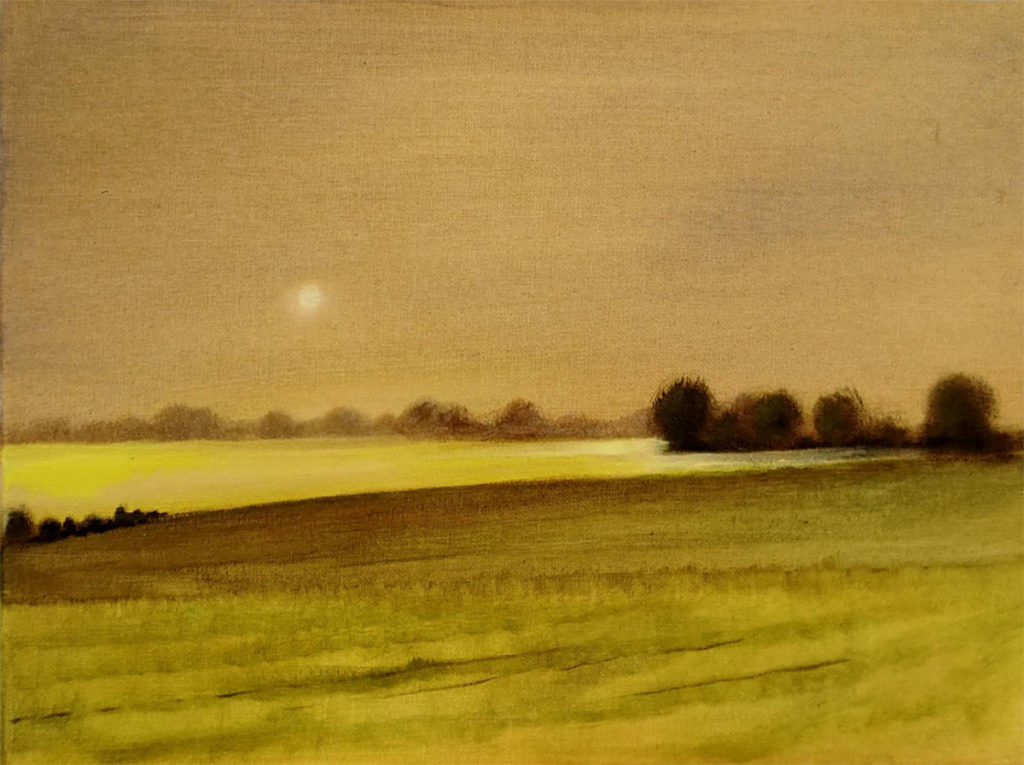
Countryside fools you at first with what seems to be a simple and unfussy composition. Look for longer though: it comes to life in the most subtle way. Long, horizontal curves elicit a sense of tranquility, space, and distance. These lines softly recline, impressing their shapes onto the landscape. The gentle curve of the horizon suggests that this landscape far exceeds the limits of the frame. There are virtually no vertical elements in this painting, further emphasizing the horizontal plane.
The most distant tree line is faded and far away, deep in the three-dimensional space of the landscape. To the right, we see that there is a part of the landscape that is hidden from view by trees. If we walked there, we would be able to go behind them and walk right out of the painting.
At its rightmost point, this treeline meets the bold curve that bisects the fields. Is this curve just crossing the landscape from right to left, or is it also coming into the foreground? Alternatively, could it be veering slightly further away, receding just a fraction? This clever spatial layering creates small uncertainties and makes us question what we are seeing. It’s the same when we look at a hot, hazy landscape under a slowly changing summer sun.
The best way to view this painting though is without dissecting it. Instead, stand back and explore the narratives that it creates. Enjoy the light and space that Harris has captured. In this British landscape, the moment of viewing is elevated to one of beauty.
Constable (1776-1837) was born in Suffolk to a prosperous family of millers and grew up in the countryside. Although expected to become a merchant like his father, Constable instead enrolled at the Royal Academy of Art in London. He regularly returned home to paint directly from his childhood landscape.
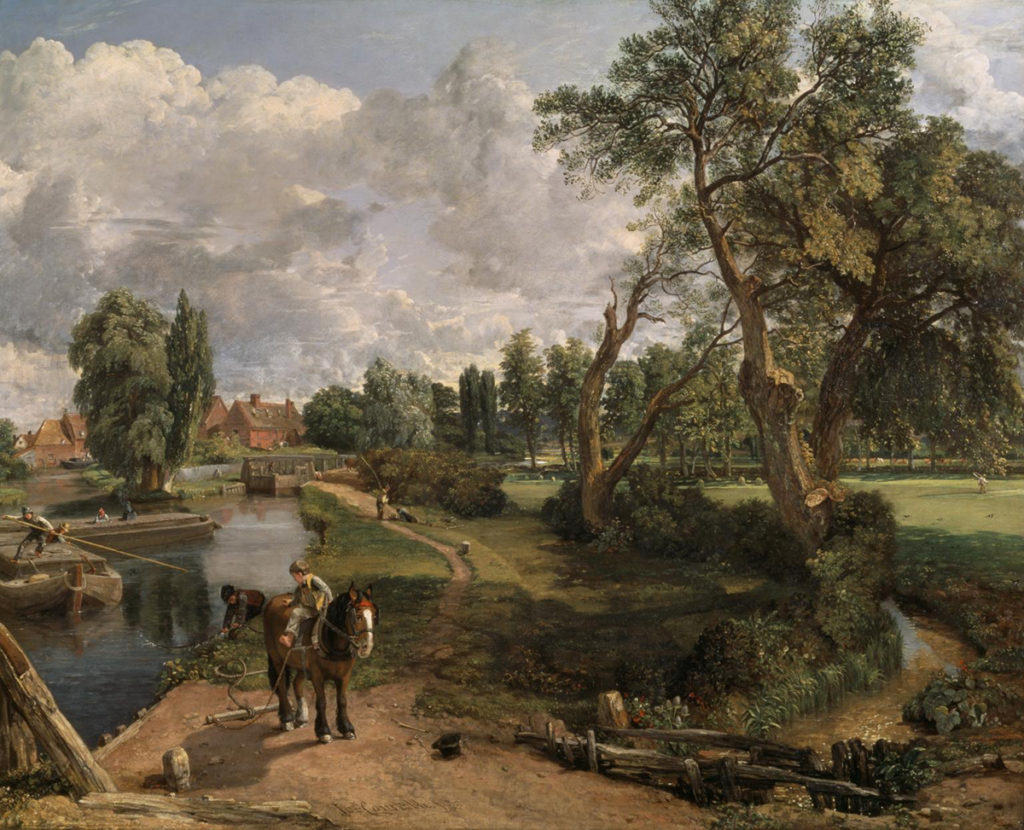
Constable rejected the stormy romance of other more fashionable British landscape painters like Turner. He found their largely uninhabited scenes alienating and sorrowful. He preferred to paint the interaction of people with the landscape rather than banish them from it. Constable regarded the countryside as home and painted it not as a brooding, unpredictable entity that defied understanding, but rather as a serene and comfortable place where people knew how to live in rhythm and balance with the natural world.
Ethelbert White (1891-1972) studied at the St. John’s Wood School of Art, London. He was predominantly a wood engraver but also worked in watercolor and oil. He was already financially secure and so he did not need to sell art to make a living. This meant that as an artist he was completely free to do whatever he wanted, so he and his wife Betty lived between a small cottage in Hampstead and a cottage at Amberley in Sussex. He also bought an old Reading caravan in which they lived as they traveled around southern England enjoying and painting nature.
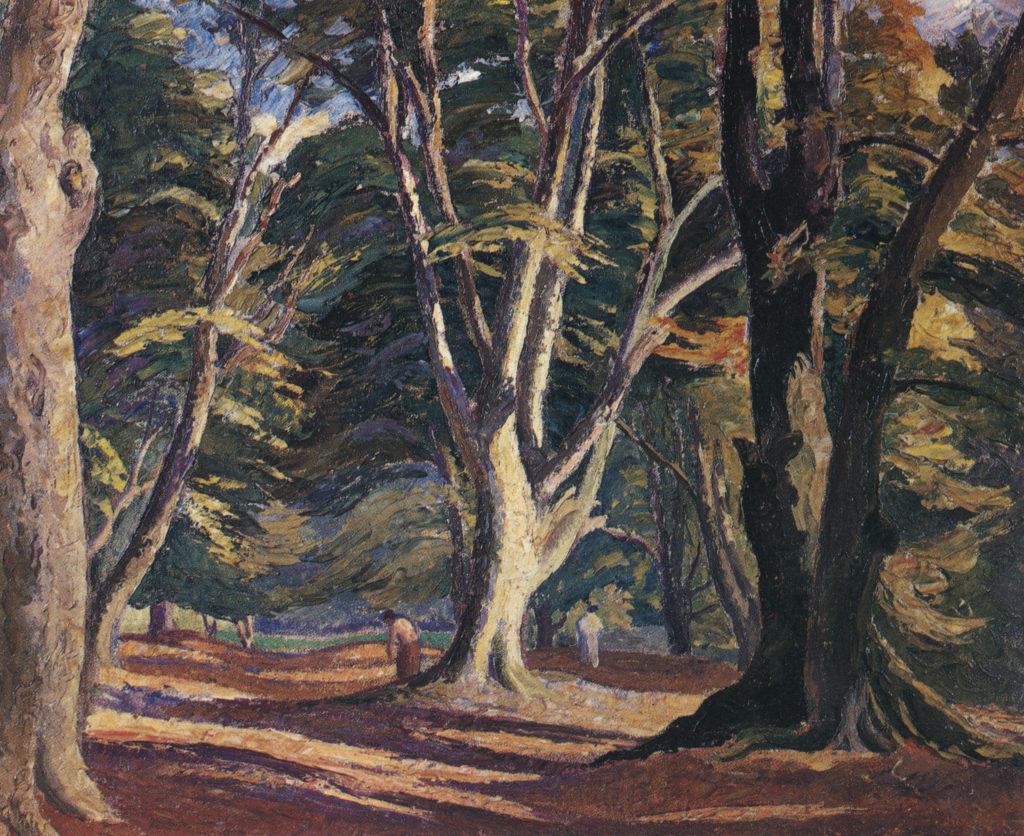
Ethelbert was particularly attached to Sussex and its woodlands, returning to them again and again. In The Forest, he shows particular sensitivity to the interplay between light and shadow. He captures the sunlight dancing on the beech leaves as something that is in a constant state of flux. Cast down to the forest floor it becomes a darkly flickering and shadowy opposing force. The light sometimes breaks through, sometimes not. He creates a vivid impression of standing in a beautiful forest and observing the subtle movements everywhere you look.
It’s possible to be inextricably drawn to a place and compelled to find ways to express it time after time. Sometimes this is for no other reason but that we love it so much it hurts. Sounds like a cliché right? However, childhood experience can be a powerful force in setting a location in someone’s psyche. Formative experiences can create all-encompassing and influential drives. Constable returned to the idyllic setting of his own childhood in preference to more fashionable landscapes. Paul Nash’s final works were of Wittenham Clumps which he had visited as a child.
We are often incapable of resistance: maybe it’s something about the history or the memory of the place – good or bad. Maybe it’s to do with the colors or the light. The sounds and tastes that the place evokes can lean on us until we feel obliged to acknowledge them as an almost physical part of ourselves. In this way the outer landscape becomes a deeply personal inner one, demanding expression.
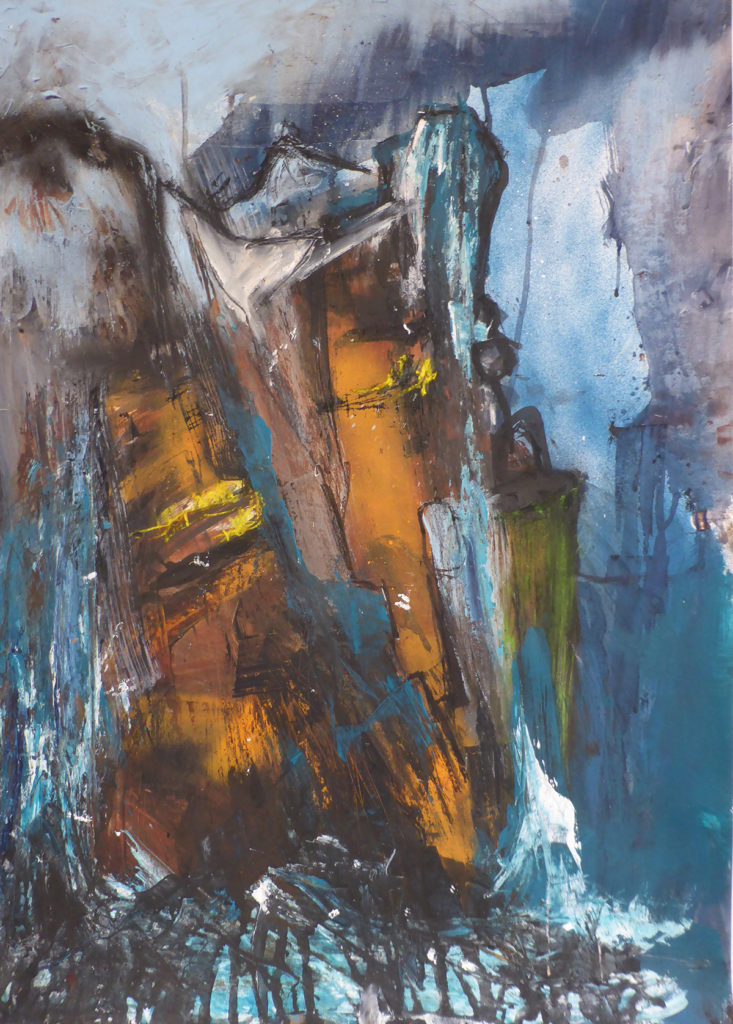
In Terri Hogan‘s Cape Cornwall II, the technique is impulsive and intuitive, readily embracing the location. This is the only landscape here that has been executed in portrait dimensions: the vertical aspect “communicates action and movement”, actively engaging us in its subjects of sea and rock. The palette reflects land and water: paler rock and green flora are lashed by the foaming sea. Rust tones evoke ideas of old tin mines, now oxidized to orange and brown: signs of the way that people lived transformed into a trace on the landscape. The existence of such a painting suggests that those influences have not yet faded. Hogan along with for example Nash or Williams feels the distant presence of our ancestors and their actions as reflected in the observable physical world.
Terri Hogan’s first love though is the sea, and she has been drawing it, and longing for it, since childhood. Humankind is a force of nature no doubt, but we come and go; sometimes traces remain, sometimes not. Whatever our interests in the sea happen to be, we can be certain that it is unstoppable, formidable, uncontrollable, and permanent. The sea shapes everything it touches, including us, and so when we view a painting like Cape Cornwall II, we might also be glimpsing the shape of the artist who made it. The sea is embedded in Terri Hogan’s work, and also in her: “My need for the sea is a physical need, if you can understand that?”.
Aristides, Juliette (2019) Figure Drawing Atelier: An Instructional Sketchbook, New York, Monacelli Studio, p. 17.
Christie’s Feature (2020) The life and legacy of J.M.W. Turner.
Wilton, Andrew (2006) Turner in his Time, London, Thames & Hudson Ltd., p. 210.
DailyArt Magazine needs your support. Every contribution, however big or small, is very valuable for our future. Thanks to it, we will be able to sustain and grow the Magazine. Thank you for your help!